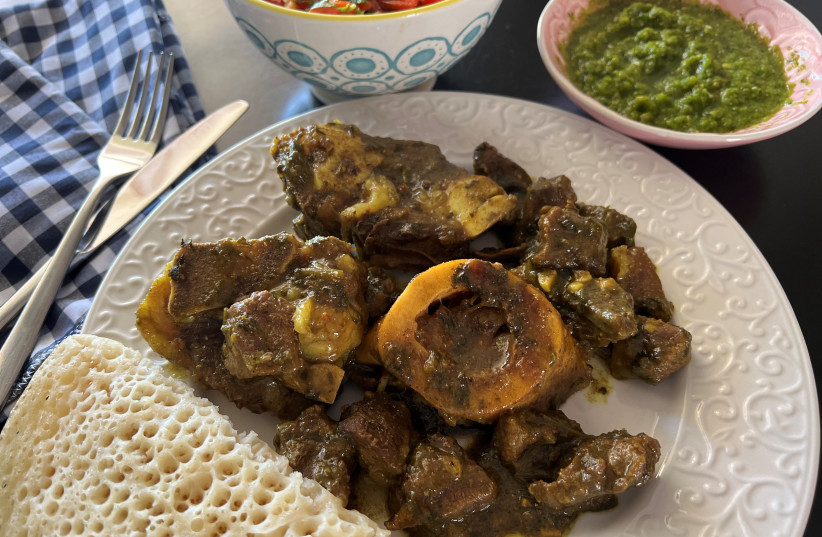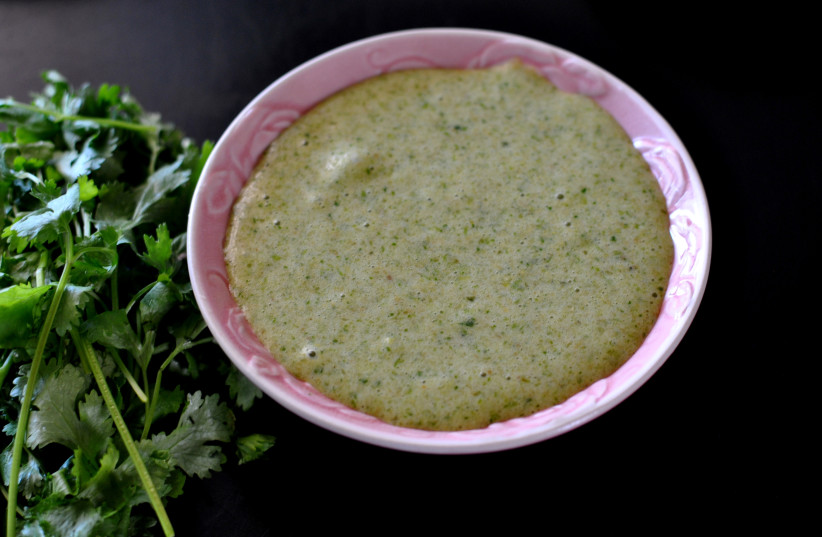Eitan Cabel has been retired from the Knesset for three years now – but that didn’t put an end to his public appearances, as he is a popular panelist on prime-time TV.
The first time I learned of Eitan’s culinary expertise was when he participated in the cooking show VIP MKR alongside his sister. I was impressed with his talent and his deep understanding of Yemenite cuisine, which he knows well from childhood.
I recently asked Eitan if I could join him in his kitchen and if he would share with me a few of his fond memories from when he was a child. Luckily, he acquiesced.
Eitan, 63, who is married to Noa and has four daughters, lives in Rosh Ha’ayin. He is warm and energetic, and can be cynical and humorous at the same time.
When I arrived at his house, he opened the door wearing a yellow apron, had a towel over his left shoulder and a huge smile on his face. As soon as I stepped inside, I was met with an incredible aroma of spices and meat. Eitan then led me to the kitchen and began lifting lids off of huge pots to show me, one by one, all of the dishes he’d prepared.

When I asked him how he managed to cook the beef until it was so tender, he told me, “In my parents’ generation, they didn’t know about different cuts of meat – they would use whatever meat they could get their hands on. Our generation, however, knows how to pick the highest-quality meat and choose which cut is appropriate for each specific dish. This affects how a given recipe will turn out.”
Next, my eyes fell upon a large blue plastic bowl, inside of which sat the batter for lahoh, Yemenite pita bread, which had been slowly rising. Eitan also excitedly showed me the s’hug (spicy pepper spread) and hilbe (fenugreek) that he’d prepared.
“I learned to cook from my mother, Shoshana Cabel, who is a real whiz in the kitchen.”
Eitan Cabel
“I learned to cook from my mother, Shoshana Cabel, who is a real whiz in the kitchen,” Eitan explained. “I love making the dishes she taught me.”
Over the years, Eitan has become quite proficient, and even prepares his own spices and herbs, preparing large quantities, which he lovingly shares with his family members.
Eitan lets me taste his hilbe, and I admit it is among the best that I’ve ever tasted – and I’ve tasted quite a few in my lifetime. It was mild, light and flavorful – but didn’t have the strong smell hilbe usually has. There were two types of s’hug on the table, as well as a fresh salad with cut-up vegetables, whose role is to sharpen the flavor of the beef and soup I was served.
Then there was the lahoh, which I used to soak up all the leftover sauce on my plate. Lahoh requires quite a bit of special preparation, and Eitan showed me how he whisked the batter, and also used the ladle to add air to the mixture, again and again.
Next, he ladled a portion of batter onto a greased frying pan, and watched as the bubbles appeared and burst.
“Look, Pascale!” he said to me excitedly. “I’m not using a nail to poke bubbles in the batter – the air was already mixed into the batter from the whisk and ladle.”
As soon as the lahoh had firmed up, he covered the pan for a few minutes, and then peeked to see if it had browned enough on the bottom. When it was ready, he removed the lahoh and placed it on a metal rack to cool.
One of the secrets of making lahoh, he explained to me, is rinsing the pan in cold water after each piece has finished cooking. Then, back to the flame, a little oil and more batter.
Eitan prepared the lahoh with obvious skill and speed. It was at this moment that I understood why he feels competent enough to prepare Yemenite food in front of the whole country on TV.
He was generous enough to share with me a few of his favorite recipes, which you’ll find below. I hope you enjoy this foray into Yemenite cuisine as much as I did.

LAHOH (YEMENITE PITA BREAD)
Makes 20 pieces.
- 1 kg. flour, sifted
- 2 Tbsp. dry yeast
- 2 Tbsp. sugar
- 1 Tbsp. salt
- 1 packet baking powder
- 7-10 cups water (disposable plastic cup)
- 1 cup oil
Add the flour to a large bowl, then add the sugar, salt and baking powder. Mix gently with a whisk. Then, gradually pour the water into the mixture, while constantly whisking quickly until all the lumps are gone. Continue whisking quickly. (Traditionally, the batter was mixed by hand, but it is much more effective to use a whisk.) Add only as much water as is needed. Whisk energetically for 15 minutes. Then, cover the bowl with plastic wrap and let the batter sit on the counter for 15-20 minutes.
Next, whisk the batter energetically again until it thickens. If the batter is too thick, you can add another cup or two of water. Cover the bowl with plastic wrap again, and let it sit for another 15 minutes.
Whisk the mixture a third time. Then, lift up the batter with the ladle, and pour it back into the bowl. Continue doing this a number of times to add air to the mixture.
Cover the bowl with plastic wrap and let it sit for 30 minutes.
If the mixture is too thick, you can add another ½ cup of water and then whisk well again. The batter should have lots of air bubbles in it.
To prepare the lahoh, pour the oil into a frying pan and heat until oil begins to bubble. Pour the oil off into a small bowl. Take a paper towel and wipe off any excess oil that remains on the pan. Increase the heat to medium-hot, then ladle some of the batter into the center of the pan. Tilt the pan so that the batter covers the pan evenly.
Wait a minute or two, until the edges have browned and the entire lahoh has firmed up. Then, cover the pan until the lahoh has finished cooking and is full of holes. Use a spatula to check that the bottom has crisped up and turned golden brown. Remove the lahoh from the pan and place it on a metal rack, with the side of the lahoh with holes facing up.
Note: You should not flip the lahoh over to cook on the second side. One side should be brown, and the other side white and full of holes.
Rinse the pan with cold running water to prepare it for cooking the next piece of lahoh. Take the paper towel you used to wipe off the oil and dip it in the bowl with the extra oil, then cover the pan with more oil.
Place the frying pan back over the flame and ladle in some more batter. Wait until the batter firms up, then cover and continue cooking another minute or two. Continue in the same fashion until you’ve used up all the batter.
Level of difficulty: Medium.
Time: 1 hour.
Status: Parve.

HILBE (FENUGREEK)
Makes 10-15 containers, 50 gr. each.
- 100 gr. fenugreek, not ground
- 6-8 leeks
- 3 cups water
Vegetables:
- 1 cup water
- 1 bunch cilantro
- 1 leek, sliced into 3 pieces (use only the white part, plus a little of the green part)
- ½ bunch scallions
- 1 spicy green pepper (optional)
Herbs:
- 4 Tbsp. (or more, according to taste) s’hug (spicy Yemenite green pepper sauce)
- 2 tsp. (or more, according to taste) salt
- 1 tsp. cumin
- 1 tsp. ground cardamom
To prepare the fenugreek, soak the seeds in water for 3 or 4 days, changing the water 3 times every day. This rinsing helps remove the bitterness and the strong smell.
To prepare the vegetables, add the water, cilantro, leek, scallion and spicy pepper to a blender. Blend on high speed until it has become smooth and velvety. Transfer to a bowl and set aside.
Next, drain off the water from the fenugreek seeds. Measure out 1 cup of drained fenugreek seeds and put them in the blender. Add 1 cup of water and 2 or 3 pieces of leek. Mix on high speed until really smooth.
Transfer the blended seed mixture to a large bowl, then add another cup of fenugreek seeds, 1 cup of water and the leek to the blender and mix on high speed. Continue until you’ve used up all the seeds.
To finalize the hilbe, mix the ground fenugreek on high speed, while adding the vegetable mixture a little bit at a time. Make sure to mix it at least 5 or 10 minutes. While mixing, add the s’hug, salt, cumin and cardamom. Mix until smooth and airy. The more you mix the hilbe, the airier it will become.
When it’s done, pour into jars. You can also freeze the hilbe for future use.
Level of difficulty: Medium-hard.
Time: 1 hour.
Status: Parve.
<br>SHWAYEH (MAHSHUSH) YEMENITE ROAST BEEF
Makes 8-10 servings.
- 2-3 Tbsp. oil
- 1 large onion, chopped finely
- 15 garlic cloves, chopped
- 1 kg. beef shoulder, cubed
- 2 marrow bones
- 2 pieces brisket on the bone (300 gr.)
- 1½ bunches cilantro, chopped
- 1 Tbsp. cumin
- 1 level Tbsp. ground cardamom
- 1 Tbsp. hawaij (Yemenite soup spice mix)
- ½ tsp. black pepper
- Salt, to taste
- ½ cup beef broth (or 2 Tbsp. beef soup powder)
- 1-2 cups boiling water
Heat the oil in a large, flat pot. Add the onion and the garlic and sauté until they become translucent. Add the beef, bones and brisket, searing them on all sides until all the meat has turned gray.
Add the cilantro and all the spices. Stir, then add the water. Cover the pot and cook over a medium-low flame for 30 minutes. Stir again, taste and adjust seasoning.
If the sauce is too thick, you can add a little water. Continue cooking over a low flame for another 1.5-2 hours until the meat has softened.
Level of difficulty: Easy-medium.
Time: 2.5-3 hours.
Status: Meat.
Translated by Hannah Hochner.
